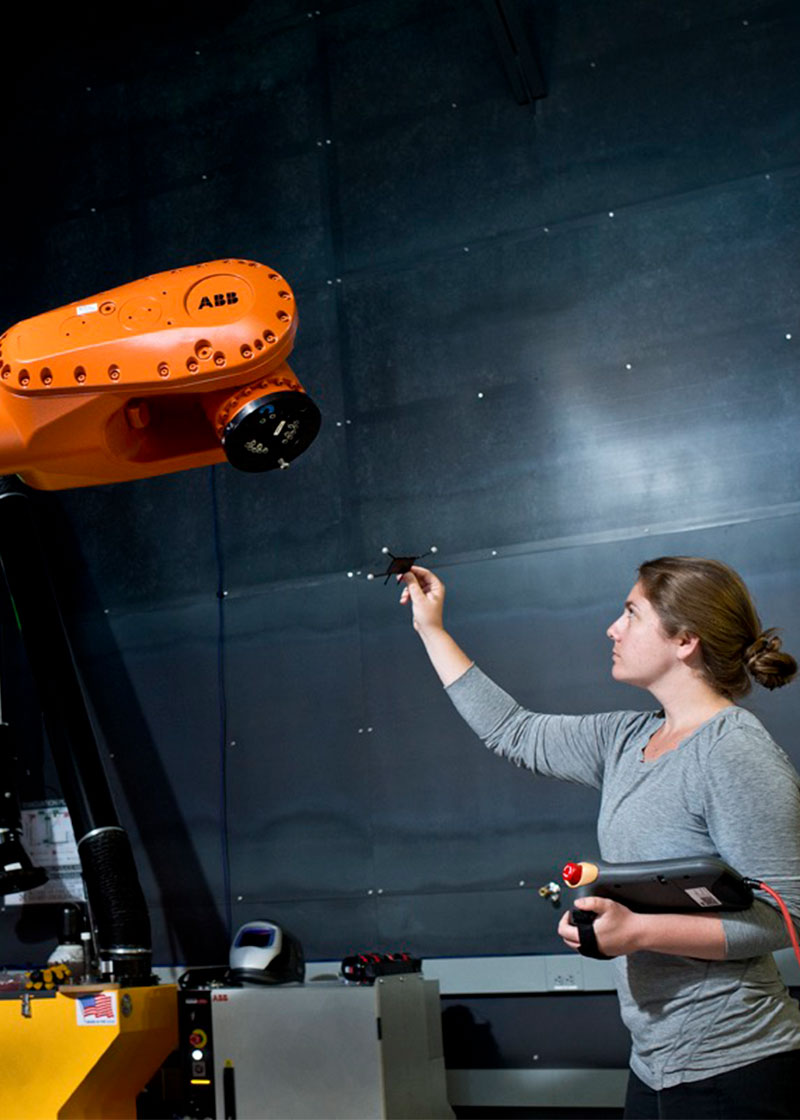Taming the Beasts
Madeline Gannon develops new ways to communicate with industrial machines
written by
April Johnston
The two-ton, six-axis industrial arm danced around Madeline Gannon, at times coming within centimeters of her outstretched hand.
It should have been terrifying; all of that raw power typically reserved for a car manufacturing line suddenly set free. It could have crushed her.
But it wasn’t the potential for death and danger that people noticed when they watched the video of Gannon and her giant, orange robot —Quipt— waltzing across the concrete floor of a workshop in San Francisco.
Instead, they marveled at the way the robot followed her like a curious puppy, longing for attention and affirmation, displaying the smooth, innate gestures of an animate creature rather than the lurching stops and starts of a mechanical being.
At the time Gannon made that video in 2015, she was a School of Architecture doctoral candidate at Carnegie Mellon University and an artist in residence at Autodesk, just beginning to work with industrial robots and understand their potential.
Today, Gannon is the founder of ATONATON, a Pittsburgh-based, independent research studio inventing new ways for humans to communicate with machines. Her work with robots has been featured in installations all over the world, including at the Design Museum of London and the World Economic Forum.
But in many ways, Gannon is still the inquisitive kid who watched squirrels chase blue jays across the yard and the analytical teen who visited the Metropolitan Museum of Art and spent more time looking at the building and the way people moved through it than at the exhibits.
She’s still an architect.
“What architecture education gives you is a hypersensitivity to how people move through space and how to best accommodate them,” Gannon said.It’s central to the way she approaches her work with robots. Her goal is to quell the prevailing narrative that robots are otherworldly and bound for domination. Instead, she sees a future where robots and humans are complementary, capable of more together than either could be alone.


And, in her view, the best way to achieve that reciprocal relationship is to imbue robots with instantly recognizable, animal-like behaviors that people can understand and respond to.
She does this by using software that allows robots to see and respond to human movement. Quipt relied on motion-capture markers to detect human intention. Another robot, Mimus, used cameras embedded in the ceiling. Gannon’s latest installation, a pack of 10 robots called Manus, shares a central brain so that it can react to its environment collectively.
In each case, while the robot’s behavior is constantly transforming, its appearance remains unaltered.
“They’re left naked, as if they would be born in the wild. That way, you can see what this raw creature is and what this raw creature isn’t. You get to look at technology in a novel, honest, transparent way.”
Madeline Gannon
Thus far, much of Gannon’s work has focused on experiences rather than practical applications because, as she noted in a 2016 presentation, what she does and hopes to eventually do “doesn’t really exist yet.”
“I like to think of myself as an advance scout for what normal will look like in 10 to 15 years,” she said.
Her latest project takes that metaphor to a new apex. She and her husband are in the midst of renovating a 10,000-square-foot warehouse in Spring Garden, which will serve as both their home and Gannon’s living laboratory, where she’ll conduct the kind of atypical, antidisciplinary research she did at CMU’s Frank-Ratchye Studio for Creative Inquiry.
“I’m very curious to see what it means to live alongside robots,” she says. “When you have them next to you day after day, it’s a catalyst for exploration.”
She’s especially eager to see how her first child — a daughter born in December 2019 — will respond to the family’s unusual houseguests.
“She’s going to be able to grow up with some robot friends,” Gannon said, laughing. “‘Of course, the walls talk and I play fetch with Roombas—don’t all children do that?’”
In many ways, watching her daughter interact with robots will be like glimpsing the very future Gannon’s work envisions, one in which the creatures are fully integrated into the world and where their abilities have been studied, tweaked and chosen.
“A lot of people believe that technology is a force of nature, that it just happens, but it’s really our collective set of choices,” Gannon says. “There’s a central role to play in showing there are better ways.”
featuring the following:
Charlie Nordstrom and Blue Bergen (Asst. Editor), Madeline, the Robot Tamer
courtesy of Madeline Gannon's YouTube channel